The post Micro-Hyaluronic Acid: The Secret to Healthy, Hydrated Skin appeared first on Stanford Chemicals.
]]>What is Hyaluronic Acid
Hyaluronic Acid (HA) is recognized as one of the best moisturizing substances currently discovered, regarded as the optimal humectant. It has an exceptional water-absorbing ability, capable of retaining water up to 1,000 times its own volume. HA is abundantly present in the skin, forming one of the main components of the skin’s extracellular matrix. This substance can bind with proteins to form larger proteoglycan molecules, ultimately creating a gel-like structure of hyaluronic acid-protein-water, which plays a crucial role in maintaining the skin’s moisture.
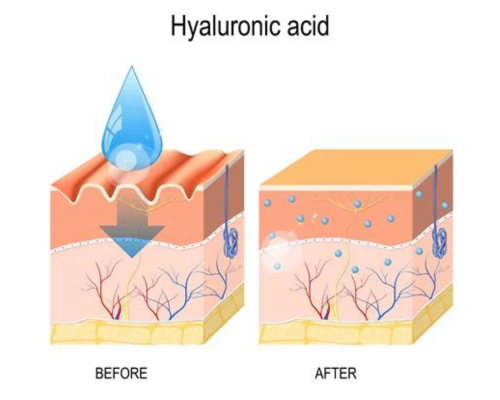
The Importance of Hyaluronic Acid for the Skin:
HA within the dermis provides space and nutrients for collagen and elastic fibers, forming a structural framework for the skin. This is essential for maintaining the stability, integration, and elasticity of skin tissues.
Hyaluronic Acids by Molecular Weight
Hyaluronic acid can be classified based on its molecular weight into:
- High Molecular Weight HA (HMW-HA): Above 1,800 KDa.
- Medium Molecular Weight HA (MMW-HA): Between 200 KDa and 1,800 KDa.
- Low Molecular Weight HA (LMW-HA): Between 5 KDa and 200 KDa.
- Oligomeric Hyaluronic Acid (Oligo-HA): Below 10 KDa.
Further subdivision identifies Micro-Hyaluronic Acid (Micro-HA) with a molecular weight below 5 KDa.
Learning more: Comparative Analysis of Hyaluronic Acid with Different Molecular Weights
Each molecular weight category has distinct physicochemical properties and application areas. HMW-HA is commonly used in ophthalmic and orthopedic surgical products due to its excellent viscoelasticity and lubricating properties. MMW-HA finds widespread applications in cosmetics, pharmaceuticals, and health products. LMW-HA is often used in cosmetics and health supplements for its better absorption. Oligo-HA and Micro-HA are primarily utilized in medical and cosmetic products.
What is Micro-Hyaluronic Acid
Micro-HA refers to ultra-low molecular weight HA fragments (below 5 KDa) obtained through the degradation of hyaluronic acid. Studies have shown that Micro-HA can quickly penetrate beneath the stratum corneum, providing long-lasting hydration to the skin. As a natural component of the human body, Micro-HA has excellent biocompatibility, offering comprehensive moisturizing and anti-aging effects. It represents a new generation of hyaluronic acid products.
Micro- Hyaluronic Acid vs. Regular Hyaluronic Acid
Micro-sodium hyaluronate stands out from regular sodium hyaluronate with the following features:
- Ultra-Low Molecular Weight: Micro-sodium hyaluronate has a molecular weight of less than 5 kDa.
- Strong Permeability: Its superior permeability allows it to penetrate the stratum corneum and reach the basal layer of the skin.
- Enhanced Moisturizing Ability: The moisturizing effect of micro-sodium hyaluronate is 6-7 times stronger than that of regular sodium hyaluronate.
- Superior Skin Affinity: While regular sodium hyaluronate forms a film on the skin’s surface that is easily washed off, micro-sodium hyaluronate binds to skin cells, providing robust hydration support and protection that is less prone to being washed away.
Advantages of Micro-Hyaluronic Acid
- Deep Moisturization
Micro-HA can penetrate the skin and provide deep hydration, significantly increasing skin moisture content. When combined with high molecular weight HA, the moisturizing effect is further enhanced synergistically.
- Repair of Damaged Cells
Micro-HA repairs damaged cells, enhancing cellular activity and reducing damage caused by external factors.
- Free Radical Scavenging
Micro-HA eliminates reactive oxygen species induced by sunlight, enhancing cellular antioxidant capacity and improving the skin’s defense against UVB radiation.
- Anti-Aging
Continuous use of skincare products containing Micro-HA improves skin elasticity, strengthens the skin barrier, reduces wrinkles, and provides anti-aging benefits.
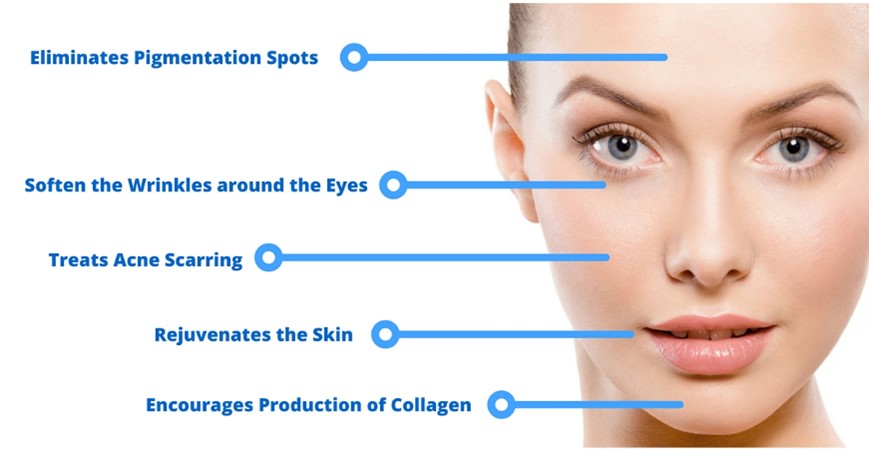
How Does Micro-Hyaluronic Acid Benefit the Skin
High molecular weight hyaluronic acid cannot penetrate the normal skin barrier and forms a breathable thin film on the skin surface. Its primary function is to keep the skin smooth and moisturized while protecting it from bacteria, dust, and UV radiation. In contrast, low molecular weight HA can penetrate the skin barrier to the dermis, suppress inflammatory responses, promote angiogenesis, improve intermediate metabolism, enhance nutrient absorption, and reduce wrinkles.
In the dermis, Micro-HA participates in the metabolism of collagen and elastic fibers, providing moisture and nutrients and enhancing skin elasticity.
In vitro experiments have shown that Micro-HA can:
- Increase collagen synthesis (+100%)
- Activate glutamine transaminase (+100%)
- Reduce matrix metalloproteinase activity (-15%)
Collagen is a key extracellular matrix component responsible for skin strength, while the proper organization and alignment of collagen fibers involve glutamine transaminase. Matrix metalloproteinases degrade collagen fibers. In summary, Micro-HA exerts anti-wrinkle effects by acting on these substances within the body.
Where to Buy the Best Micro Hyaluronic Acid
Stanford Chemicals Company (SCC) is a wholesale supplier of pure organic hyaluronic acid in the USA. The company has rich experience in medical-grade, cosmetic-grade, Injection-Grade, and food-grade sodium hyaluronate. The high molecular weight, middle molecular weight, low molecular, and oligomeric weight hyaluronic acid powder are available as well. We offer hyaluronic acid raw materials to customers in the USA, Canada, and Europe. A detailed description of Micro-HA is listed below. For further information, please make your inquiry.
020-000-118 Micro Hyaluronic Acid Specification
| Product name | Super Active Hyaluronic Acid |
| INCI Name | Hydrolyzed Sodium Hyaluronate |
| Molecular weight | <5k Da (average: 3k Da) |
| Appearance | Almost white or pale yellow powder |
| Recommended dosage | 0.05%-0.5% |
| Solubility | Soluble in water; Can be added directly to water |
| Application | skincare, eye drops for lubrication, dermal fillers, joint supplements, and wound care |
The post Micro-Hyaluronic Acid: The Secret to Healthy, Hydrated Skin appeared first on Stanford Chemicals.
]]>The post What Are the Top Benefits of Micro Hyaluronic Acid for Your Skin? appeared first on Stanford Chemicals.
]]>Micro Hyaluronic Acid generally refers to hyaluronic acid (HA) with a smaller molecular weight. It is a form of hyaluronic acid typically within the low molecular weight range (below 100k Daltons or lower).
Hyaluronic acid, often referred to as HA, is a naturally occurring sugar in our skin that helps retain water, keeping it hydrated and plump. What’s remarkable about it is its ability to hold up to 1,000 times its weight in water. Beyond simply holding water, it helps lock moisture in the skin, preventing evaporation into the air.
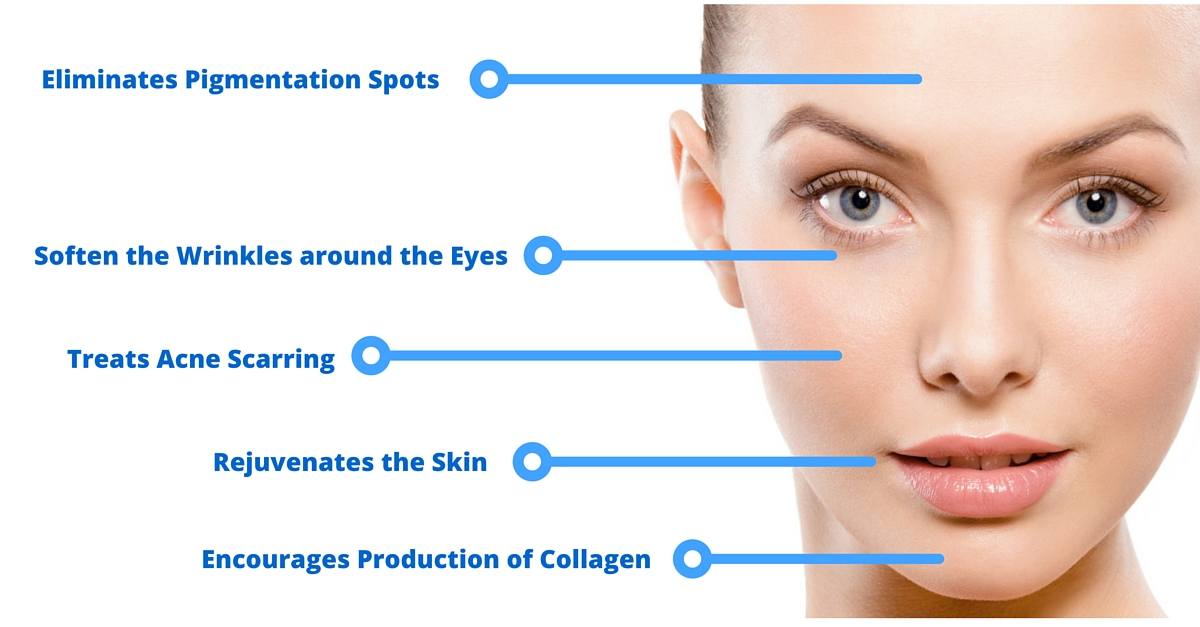
To put that in perspective, just ONE gram of Micro Hyaluronic Acid can hold six liters of water. It also regulates moisture within the skin cells so as to not drown them. Not only can Micro Hyaluronic Acid boost your skin’s moisture levels, but it keeps your skin hydrated for long-term positive effects. You may also find it as sodium hyaluronate, which is derived from HA and is the sodium salt portion of HA that has been isolated.
Micro Hyaluronic Acid vs. High Molecular Weight Hyaluronic Acid
Micro hyaluronic acid has stronger penetration compared to other molecular weights of hyaluronic acid, allowing it to pass through the skin barrier and reach the dermis. Its low molecular weight structure enables faster absorption, enhancing the efficiency of skincare products. Micro hyaluronic acid performs exceptionally well in anti-aging skincare and is often combined with high molecular weight hyaluronic acid to achieve the dual effect of deep hydration and surface protection.
Why Is Micro Hyaluronic Acid Used in Skincare?
With all of that, if you’re looking for plump, elastic, skin, Micro Hyaluronic Acid is going to be a favorite of yours. If a topical product claims to be hydrating, it likely is powered by Micro HA. But aging and environmental aggressors reduce the naturally occurring Micro HA in your body, making it an incredibly valuable active ingredient.
What Are the Top Benefits of Micro Hyaluronic Acid for Your Skin?
• It hydrates and plumps skin, reducing the appearance of fine lines and wrinkles as well as generally reducing signs of aging.
• It promotes a healing environment in the skin, reducing redness and dermatitis.
• It has antioxidant properties, which could protect the skin from environmental aggressors.
• It’s ideal for all skin types, even sensitive, acne-prone, or oily skin.
Because of all these incredible benefits, Micro Hyaluronic Acid is one of the best skincare active ingredients on the market.
What Is the Right Way To Apply Micro Hyaluronic Acid?
There are many forms of Micro Hyaluronic Acid. It exists naturally in your body, for example, but it also exists as an injectable filler (like Juvéderm and Restylane). However, you’re likely most familiar with it as the active ingredient in topical products from serums to face masks to moisturizers and more. The most popular Micro Hyaluronic Acid products are serums, which are best used after toner and before moisturizing.
The post What Are the Top Benefits of Micro Hyaluronic Acid for Your Skin? appeared first on Stanford Chemicals.
]]>The post Application of Micro Hyaluronic Acid as Carriers in Drug Delivery appeared first on Stanford Chemicals.
]]>The problem plaguing our customer
One of our customers faced a problem, macromolecule active ingredients (or at least 500KD) are historically difficult or impossible to deliver topically through tissue structures with the limitation of traditional methods.
The customer is a clinical-stage bio development company whose objective is to reduce society’s exposure to potentially harmful active agents by utilizing novel permeation technology to deliver active agents through tissue structures more efficiently.
“The topical delivery of large molecules through the skin, hair, eyes, mucosal surfaces, and bone are difficult using traditional hyaluronic acid.” said a medical director from one of our customers.
In the past, the most common form of hyaluronic acid in the pharmaceutical industry is high molecular weight HA, usually, more than 1800 K Da.
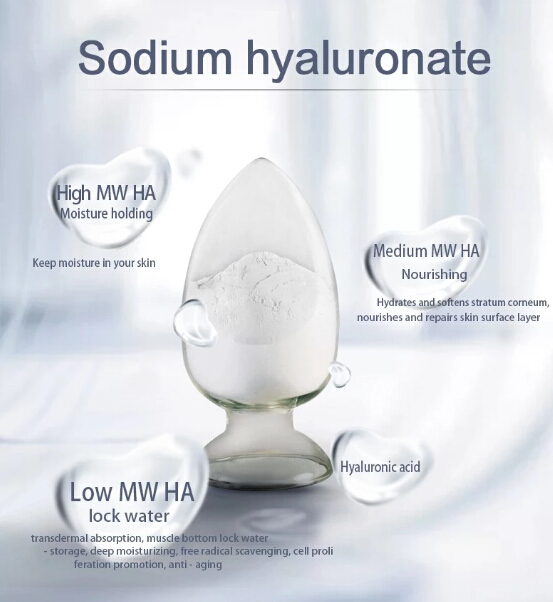
Low-molecular HA VS High-molecular HA
The difference between high-molecular hyaluronic acid (≥1,800 kDa) and low-molecular-weight HA (10 kDa ~1,000 kDa) is that the low-molecular-weight HA has been split into smaller fragments. The smaller fragments can no longer form a gel with water like the large molecules, but they can penetrate the skin much easier and have a better anti-irritant and regenerating effect once absorbed by the skin.
Why choose Stanford Chemicals?
In the past, the customer had purchased traditional mini HA (>10K Da) for its pharmaceutical delivery research. Over the years, Stanford Chemicals has developed HA with the low molecule that has stronger skin penetration, named micro hyaluronic acid (micro HA), which is a low molecular weight HA (<5K Da). It is even lower than the mini HA. The main functions of Micro HA are recovery and super moisturizing the tissues.
Stanford Chemical’s Micro-HA Super Active hyaluronic acid was used in Illustris molecule delivery technology to help facilitate a permeation process of the drugs in the human body. Micro hyaluronic acid as a drug carrier contributes to drug thickening, sustained release, transdermal absorption, and improved drug targeting.
By adopting the low molecular weight HA, the customer is able to provide a significant competitive advantage to molecule delivery, yielding enhanced safety and efficacy for patients.
Main Features of Micro HA
Since 5 kDa HA revealed a much more pronounced absorption activity through the skin than it could be observed for 10 kDa HA. Due to its micro size, micro-HA super active hyaluronic acid penetrates deep into the skin and other tissue structures easily, optimizing the absorption of compounds delivered through the skin, eyes, and mucosal. With the addition of micro HA, the cell proliferation rate of macromolecule active ingredients increased significantly; 0.125% micro HA can make the cell proliferation rate increase up to 94%.
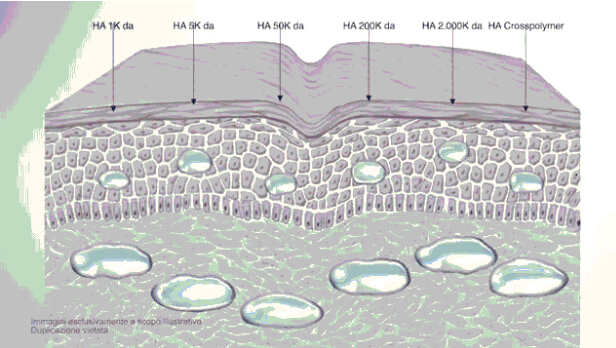
There are 2 Benefits for Our customers
After utilizing our products Micro Hyaluronic Acid in its revolutionary delivery technology, they provide a significant competitive advantage with its novel approach to molecule delivery, yielding enhanced safety and efficacy for patients
“We are pleased to have used micro HA for Illustris’ innovative delivery technology,” said a technician from the pharmaceutical company, “We are eager to use micro HA and showcase its significant advantages over current drug delivery technology.”
Our customers benefited in the following ways:
Revolutionized HA solution for drug delivery system
The customer enables the delivery through tissue structures of macromolecule active ingredients (or at least 500KD) which are historically difficult or impossible to deliver topically and optimizes the delivery of active agents which previously permeated tissue structures inefficiently. It is easy for active ingredients to permeate the targeted site with Micro HA. Now, it enables the delivery of large molecules (up to 160KD) through tissue structures easily and optimizes the absorption of compounds typically delivered through skin, eyes, and mucosal surfaces.
Lower Cost
Stanford Chemicals (SCC) supplies high-purity micro HA at a very competitive price. Since the advanced specification of micro-HA, our customers can research its innovative delivery technology for pharmaceuticals easily. Therefore, this is a win-win result, it is also good news for the HA market. We are both happy with this transaction.
There are several benefits to using SCC micro HA throughout the pharmaceutical delivery process. For pharmaceutical companies with similar applications, our engineering team can provide a customized solution for your project. Feel free to contact us at [email protected].
The post Application of Micro Hyaluronic Acid as Carriers in Drug Delivery appeared first on Stanford Chemicals.
]]>The post Micro Hyaluronic Acid for Cosmetic Applications appeared first on Stanford Chemicals.
]]>The topical delivery of large molecules through skin, hair, eyes, mucosal surfaces and bone is difficult using high molecular weight hyaluronic acid.
In the past, the most common form of hyaluronic acid is high molecular weight, usually, more than 1800 K Da.
The difference between regular, high-molecular hyaluronic acid (HA) and low-molecular-weight HA is that the low-molecular-weight HA has been split into smaller fragments.
Thereby, these smaller fragments can no longer form a gel with water like the large molecules, but they can penetrate the skin much easier and have actually a better anti-irritant and regenerating effect once absorbed by the skin.
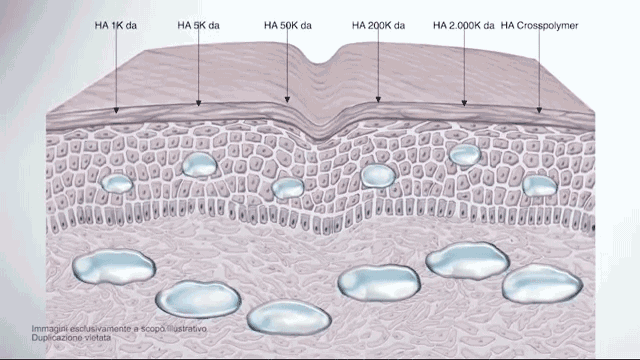
super active hyaluronic acid
Now, after several years, our new product Micro-HA Super Active hyaluronic acid was used in Illustris molecule delivery technology to help facilitate a permeation process.
Micro HA is a kind of very low molecular weight HA (<5K Da). It is even lower than mini HA (<10K Da).
Micro Hyaluronic Acid helps plump skin to improve volume and suppleness. Due to its micro size, it penetrates deep into the skin to infuse moisture below the surface, providing skin replenishment and moisturization from the inside out.
Micro-HA Super Active Hyaluronic Acid is a new low molecular weight active ingredient produced by a unique enzymatic degradation technology with superb biological activity. Micro-HA can quickly penetrate the epidermis and the dermis to scavenge free radicals, reduce inflammation factor activity, repair damaged cells, and protect the skin against inflammation and sensitivity caused by various stimuli.
In the past, the traditional industry or traditional HA-related products are more suitable for adults. However, after several years, we have designed a brand new product of HA. It is named micro HA. Micro HA is a kind of very low molecular weight HA (<5K Da). It is even lower than mini HA (<10K Da). The main functions of Micro HA are recovery and super moisturizing the tissues. It can increase the protection of baby care from daily life.
One of the examples from our customers
One of our regular customers was focused on personal care products. In the past, they sell more products for adults, especially for women. However, after utilizing products Micro HA in their new products, they obtained a lot. It is not only can enrich their product sorts, but also expand the market sales for their company. Since the advanced specification of micro-HA, they can search the new products for baby care. Therefore, this is a win-win result, it is also good news for the HA market. We are both happy about this transaction.
The post Micro Hyaluronic Acid for Cosmetic Applications appeared first on Stanford Chemicals.
]]>